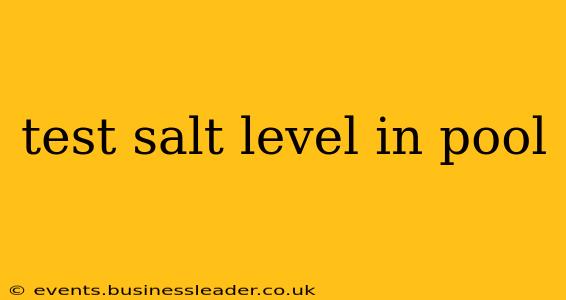Maintaining the correct salt level in your saltwater pool is crucial for the efficient operation of your chlorine generator and overall pool health. Too little salt, and your system won't produce enough chlorine; too much, and you risk damaging your equipment and irritating swimmers. This guide will walk you through accurately testing your pool's salt level and understanding the results.
What is the Ideal Salt Level for a Saltwater Pool?
The ideal salt level for a saltwater pool typically ranges from 2,700 to 3,400 parts per million (ppm). However, always check the manufacturer's recommendations for your specific chlorine generator, as this range can vary slightly. Staying within this recommended range is key to optimal performance and longevity of your system.
How to Test Your Pool's Salt Level: The Easy Methods
There are several ways to accurately test your pool's salt level. Here are the most common and reliable methods:
1. Using a Saltwater Pool Test Strip:
This is the quickest and easiest method, ideal for regular monitoring. These strips are readily available at most pool supply stores. Simply dip the strip into your pool water, wait the recommended time (usually a few seconds), and compare the color change to the chart on the container. While convenient, test strips offer less precision than other methods.
2. Using a Saltwater Pool Test Kit:
A liquid test kit provides more accurate results than test strips. These kits typically involve adding reagents to a water sample from your pool and comparing the resulting color to a color chart. Follow the manufacturer's instructions carefully for accurate results.
3. Using a Digital Salt Meter:
For the most precise measurements, a digital salt meter is recommended. These meters directly measure the salt concentration in your pool water, providing a numerical reading in ppm. Digital meters offer the most accurate results and are beneficial for fine-tuning your salt levels.
What if My Pool's Salt Level is Too High or Too Low?
What if my pool salt level is too high?
If your salt level is too high, it can lead to corrosion of your pool equipment, including the cell in your chlorine generator. Additionally, high salt levels can irritate swimmers' skin and eyes. To lower the salt level, you'll need to drain a portion of the pool water and refill it with fresh water. The amount of water you need to drain will depend on how high your salt level is and the size of your pool.
What if my pool salt level is too low?
A low salt level means your chlorine generator won't produce enough chlorine to effectively sanitize your pool, leading to algae growth and potential health risks. To raise the salt level, simply add salt to your pool. Use pool-grade salt (sodium chloride), and add it gradually, ensuring it dissolves properly to avoid clumping at the bottom of the pool. Remember to always follow the instructions on your salt meter or test kit regarding how much salt to add.
How often should I test my pool’s salt level?
Ideally, you should test your pool's salt level at least once a week, especially during periods of high pool usage or significant rainfall. More frequent testing may be necessary if you notice any issues with your pool's water clarity or chlorine levels.
What type of salt should I use for my saltwater pool?
Always use pool-grade salt, which is specifically formulated for use in saltwater chlorination systems. Avoid using table salt or other types of salt, as they can contain impurities that can damage your pool equipment.
What are the signs of an incorrect salt level in my pool?
Signs of an incorrect salt level can include cloudy water, a chlorine generator that isn't producing enough chlorine, and corrosion of pool equipment. Also pay attention to your skin and eyes when swimming. Irritation can be a sign of high salt levels.
By regularly testing and maintaining the correct salt level in your saltwater pool, you'll ensure the optimal performance of your chlorine generator, a clean and healthy swimming environment, and prolong the life of your pool equipment. Remember to consult the manufacturer’s guidelines for your specific system for the most accurate information.
